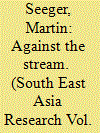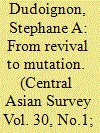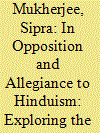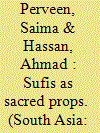|
|
|
Sort Order |
|
|
|
Items / Page
|
|
|
|
|
|
|
| Srl | Item |
| 1 |
ID:
099454


|
|
|
|
|
| Publication |
2010.
|
| Summary/Abstract |
Both Thai and Western academia have recently paid increasing attention to the changing roles of Thai Buddhist women. Still conspicuously missing, however, are more in-depth studies of female Buddhist saints in Thailand and the attendant symbolism, which would provide a more adequate depiction of the contemporary Thai Buddhist landscape. Similar to the prominent role of the mae chi in monastic education, the emergence of hagiographies and the veneration of female Buddhist saints has not, to date, been given sufficient attention in academic studies. To help remedy this situation, this paper provides a life account of one of the most outstanding female practitioners of modern Thai Buddhism: Mae Chi Kaew Sianglam (1901-1991). A summary of an increasing number of available biographical materials on Mae Chi Kaew's life is followed by a thematic analysis in which the author examines various aspects of her life accounts and her veneration. The purpose is to study the enormous significance of Mae Chi Kaew's biographies and attendant symbolic representations in the context of the religious landscape of Thai Buddhism. The author shows that many hagiographical elements in the sacred biographies of Mae Chi Kaew approximate the hagiographical paradigms not only of the Buddha and other Pali canonical figures, but also of modern saints of the Thai forest tradition. At the same time, however, significant hagiographical and venerational particularities can be observed.
|
|
|
|
|
|
|
|
|
|
|
|
|
|
|
|
| 2 |
ID:
104061


|
|
|
|
|
| Publication |
2011.
|
| Summary/Abstract |
On the basis of a reconstruction of the careers of a variety of religious personnel of Islam in the Tajik Soviet Socialist Republic, from de-Stalinization to independence, this article aims to shed light on some neglected features of Islam in Soviet Central Asia. Questioning the present-day hagiographic process, and confronting the data of oral history with those of pre-modern Muslim hagiography and biographies of religious scholars, this article assesses the specific Islamic revival that has been taking place in Central Asia in the aftermath of the reopening of the Gulag in 1955-56. It also deals with the lasting Kulturkampf, engineered by the Soviet authorities, between the Fergana-born Uzbek-speaking accredited staff of the Muslim Spiritual Board on the one hand, and the Persian-speaking leaders of prominent Sufi lineages with Bukhara and Samarqand pedigrees on the other. The role of mass population transfers in this phenomenon is evoked through their impact on the disruption of the Sufi masters' sacred 'territories' (Persian: qalamraw), and the increasing role of the latter as community builders. Acting as alternative figures to pre-modern khans, the Soviet saints of Islam, who have become the objects of a rich hagiographic process, are also introduced as the bearers and transmitters of pre-modern court culture that vanished from Central Asia in the early 1920s. Special consideration is given to the mutual relationship and competition between the scholars ('ulama) of the Spiritual Board and the gnostics ('urafa) of the Sufi paths, as well as to the former's contribution to a revival of Turkic Islamic culture - notably through the comment of Chaghatay didactical literature within active, though underground, literary circles.
|
|
|
|
|
|
|
|
|
|
|
|
|
|
|
|
| 3 |
ID:
159392


|
|
|
|
|
| Summary/Abstract |
The article studies the Bangla hagiography of Harichand Thakur, the founder of the Matua sampraday, a sect that broke away from Brahmanical Hinduism in nineteenth-century Bengal. The paper explores how the hagiography takes on the added task of constructing the collective identity of the Matuas. It argues that for a vulnerable and marginalised community where the hagiography is among the few books published, the text serves to validate the community's aspirations and authenticates its legacy. The sect, founded in opposition to the dominant Brahmanical hegemony that had kept them suppressed for generations, has been an upwardly mobile community in the twentieth century. The essay examines the changing presentations of the hagiography over a century to explore how the Matua community walks a fine line between opposition and allegiance to the majoritarian Hindu faith, and how the indeterminate boundaries between myth and history, fact and fiction, are used in this project of the community's self-construction.
|
|
|
|
|
|
|
|
|
|
|
|
|
|
|
|
| 4 |
ID:
190730


|
|
|
|
|
| Summary/Abstract |
Sufism has been subjected to reformist ideas, whether by the colonial Orientalists or the post-colonial Islamic Republic of Pakistan. This research investigates the process of colonial and post-colonial reformism through the hagiographical transmutation of a malāmatī Qādirī Sufi, Shāh Ḥusayn. It observes that the idea of colonial reformism cannot be thoroughly applied in this case—the post-colonial Pakistani state rigorously implemented its reformist policies and transmuted the saint’s image, while Western academia depicts him as queer. Therefore, the paper argues that Sufis have been used as sacred props by colonial and post-colonial reformists and scholars, resulting in multiple and contradictory Shāh Ḥusayns.
|
|
|
|
|
|
|
|
|
|
|
|
|
|
|
|
|
|
|
|
|